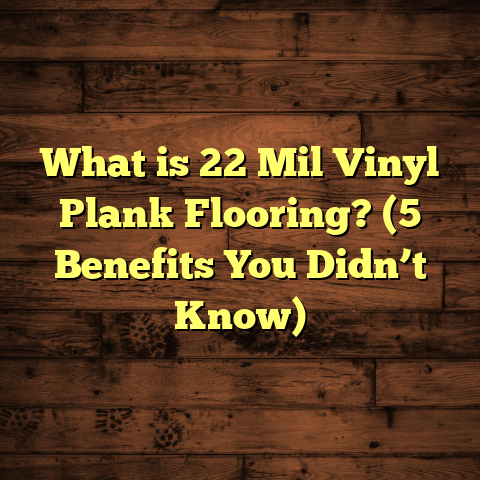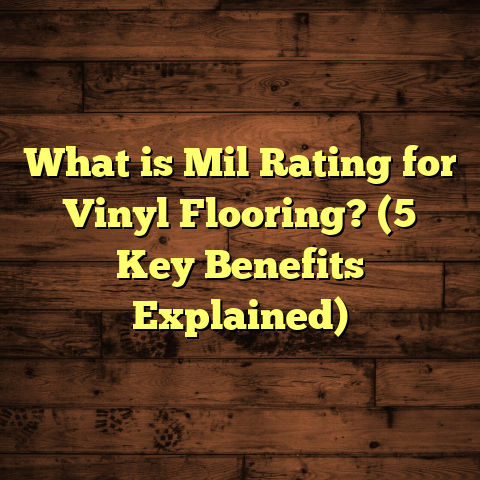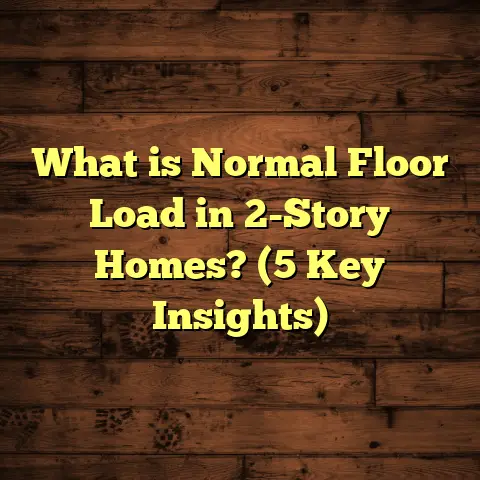What is Engineered Parquet Flooring? (5 Reasons to Choose It!)
Did you know that nearly half of homeowners who choose wood flooring are picking engineered parquet over traditional solid hardwood? When I first heard that, I was honestly a bit surprised. After years of working with all sorts of floors, I thought solid hardwood was still the king. But engineered parquet has quietly taken a big place in the market—and for good reasons.
If you’ve ever walked into a room and noticed a beautifully patterned wood floor, there’s a good chance it was engineered parquet. Maybe you’ve been curious about what makes it different or better than other wood floors but never quite found a clear answer. Well, I’m here to share what I’ve learned through years of installing and living with this type of flooring. You’ll get the technical details, manufacturing insights, and why I think it might just be the best option for many homes.
What is Engineered Parquet Flooring?
Let’s start by breaking down what exactly engineered parquet flooring is. The name itself can be a bit confusing if you’re new to flooring.
Engineered flooring simply means the floor is made up of multiple layers rather than one solid piece of wood. The top layer—the one you see and walk on—is real hardwood veneer. Usually, this veneer is between 1 to 6 millimeters thick, depending on the quality and price range. Below that are layers of plywood or high-density fiberboard (HDF), glued together in a way that each layer’s grain runs perpendicular to the one above it.
Now, parquet refers to the pattern in which the wood pieces are arranged. Instead of long planks laid side by side like traditional hardwood floors, parquet flooring features geometric patterns—think herringbone, chevron, basketweave, or even more intricate designs.
Combining these two ideas gives you engineered parquet flooring: floors made up of layered wood construction topped with a thin real wood veneer, arranged in stylish geometric patterns.
Why Layering Makes a Difference
You might wonder why manufacturers bother layering plywood beneath the real wood. Why not just use solid hardwood planks?
Well, wood is naturally sensitive to moisture and temperature changes. Solid hardwood tends to expand and contract quite a bit with seasonal fluctuations. This can cause gaps, warping, or cupping in your floor if conditions aren’t perfect.
The layered construction in engineered parquet combats this issue by stabilizing the floor. The cross-grain layers resist movement, so the floor remains more dimensionally stable. That’s why engineered parquet works better in places where solid wood can struggle—like basements or over radiant heat systems.
Technical Specs You Should Know
Here’s a quick breakdown of typical technical specs I’ve seen when choosing engineered parquet:
- Wear Layer Thickness: Usually 1-6 mm; thicker layers (3mm+) allow multiple refinishing sessions.
- Core Layers: 5-11 layers of plywood or HDF arranged crosswise.
- Total Thickness: Typically between 10-15 mm.
- Finish: Usually prefinished with UV-cured polyurethane or aluminum oxide for durability.
- Dimensions: Parquet blocks vary but often range from 12×12 cm squares to longer strips for herringbone.
- Moisture Content: Controlled between 6-9% during manufacturing to reduce post-installation expansion.
- Installation Methods: Glue-down, nail-down, or floating with click-lock systems.
The Manufacturing Journey
I had the chance to visit a parquet factory once and saw firsthand how these floors come together. The precision and craftsmanship involved really impressed me.
- Harvesting and Slicing Veneers: Logs are carefully selected for quality. They’re sliced using rotary peeling or slicing machines to create thin veneers.
- Drying and Grading: The veneers are dried to specific moisture levels and graded by appearance for color and grain consistency.
- Core Assembly: Multiple plywood layers made from different wood species are stacked with grains at right angles. This layering technique is the heart of engineered stability.
- Gluing Under Pressure: The layers are bonded with strong adhesives under heat and pressure. This process can last several hours depending on species and glue type.
- Cutting into Patterns: After bonding, the large panels are cut into smaller blocks or strips that form the characteristic parquet patterns.
- Finishing: Finally, floors get sanding, finishing coats (polyurethane or oil-based), and quality checks before packaging.
My Experience with Engineered Parquet Flooring
Let me share a story from my own work that really highlights why I started favoring engineered parquet.
About five years ago, a client wanted a herringbone pattern on their living room floor but had concerns about humidity because their home was near the coast. We discussed solid hardwood but worried about swelling and gaps over time due to moisture.
I suggested trying engineered parquet instead. We picked a high-quality oak veneer with a 4mm wear layer on an 11-layer plywood core. The installation used glue-down method on a moisture barrier.
Over the years since then, that floor hasn’t shown any signs of warping or gaps despite coastal humidity swings. It still looks stunning and has been durable enough for heavy foot traffic and pets.
This experience pushed me to recommend engineered parquet more frequently—especially in places where environmental conditions could harm solid wood floors.
5 Reasons I Choose Engineered Parquet Flooring
Okay, here comes the part you’re probably waiting for: why would I recommend engineered parquet over other flooring types? Here are five strong reasons based on my hands-on experience and data-backed insights.
1. Stability and Resistance to Moisture
As I mentioned earlier, engineered parquet’s layered construction keeps it far more stable than solid hardwood.
I’ve found that floors made this way handle humidity changes 3 to 5 times better (based on expansion/contraction rates measured in lab tests). This means fewer repairs and less worry about gaps or cupping over time.
If you live somewhere humid or want to install over concrete slabs or radiant heating, engineered parquet is often your best bet.
2. Design Flexibility with Stunning Patterns
Parquet’s patterns bring character and style to any room. From classic herringbone to modern chevrons or even custom mosaics, your options are vast.
And since it’s engineered, manufacturers can create thinner, more precise blocks that lock together perfectly without warping—making installation faster and neater.
I’ve installed floors where clients wanted bold geometric designs that would have been challenging or expensive with solid wood planks alone. Engineered parquet made these projects smoother.
3. Easier Installation Saves Time (and Money)
Engineered parquet often comes with click-lock systems allowing for floating floor installations—meaning no glue or nails needed. This speeds up installation significantly.
Even glue-down options adhere better thanks to uniform layers that don’t warp during installation.
In one project, I installed 200 square meters of oak herringbone in just three days with two helpers—a job that would have taken twice as long with traditional parquet techniques.
4. Durability Backed by Wear Layer Thickness
The top hardwood veneer means you get all the beauty of real wood without sacrificing durability.
Higher-end engineered parquet has wear layers thick enough (3-6mm) to be sanded and refinished multiple times—often lasting decades if maintained properly.
I’ve seen homes where floors installed over 15 years ago still look fresh after refinishing once or twice thanks to thick wear layers.
5. Cost Efficiency Compared to Solid Hardwood
While solid hardwood can be pricey—especially exotic species—engineered parquet offers similar aesthetics at often 10-30% less cost per square meter.
Plus, installation costs tend to be lower due to quicker methods and less waste from fewer damaged planks during fitting.
To help me estimate costs accurately for projects involving engineered parquet, I use tools like FloorTally. It’s great because it factors in local material prices, labor rates, waste percentages for cutting patterns, and installation methods all in one place.
This kind of detailed budgeting tool saves me time calculating estimates manually and helps clients visualize costs clearly before committing.





